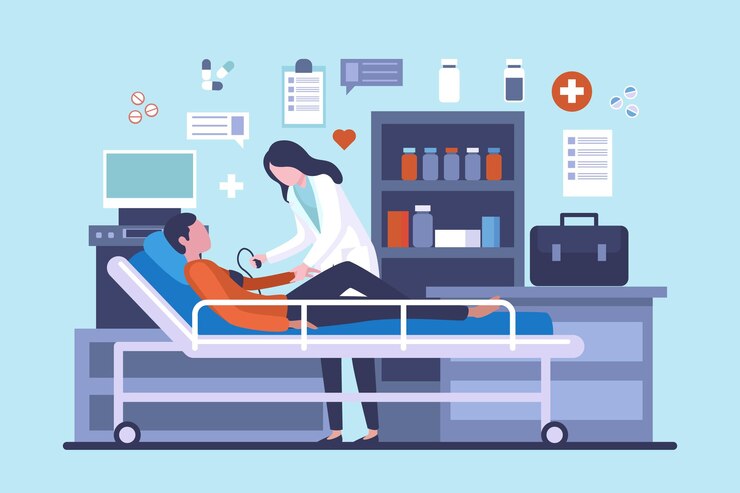Introduction to Urgent Care EMR
In today’s fast-paced healthcare landscape, the efficient management of patient information is paramount. Electronic Medical Records (EMRs) have revolutionized the way healthcare providers access, store, and share patient data. Urgent care facilities, which cater to patients requiring immediate medical attention for non-life-threatening conditions, benefit greatly from specialized EMR systems tailored to their unique workflows and requirements.
Features and Benefits of Urgent Care EMR
Urgent Care EMR systems come equipped with a plethora of features designed to streamline processes and enhance patient care. These include:
- Streamlined Patient Check-in Process: EMR solutions allow for seamless patient registration, reducing wait times and improving overall patient satisfaction.
- Integration with Laboratory and Imaging Services: EMRs facilitate integration with diagnostic services, enabling healthcare providers to access test results and imaging reports directly within the system.
- Customizable Templates for Efficient Documentation: Customizable templates enable providers to document patient encounters quickly and accurately, ensuring comprehensive medical records.
- Secure Patient Data Management: Robust security measures safeguard patient information, including encryption, access controls, and compliance with regulatory standards such as HIPAA.
- Accessibility for Healthcare Providers On-the-Go: Cloud-based EMR systems provide flexibility, allowing providers to access patient records securely from any location with an internet connection.
- Reporting and Analytics for Performance Improvement: EMRs offer robust reporting capabilities, enabling urgent care facilities to analyze trends, monitor key performance indicators, and identify areas for improvement.
Implementation of Urgent Care EMR Systems
The successful implementation of an Urgent Care EMR system requires careful planning and execution. Key steps include:
- Assessing the Practice’s Needs and Requirements: Understanding the specific workflows and challenges of the urgent care facility is essential in selecting the most suitable EMR solution.
- Choosing the Right EMR Vendor: Selecting a reputable vendor with experience in urgent care settings is crucial. Factors to consider include system functionality, ease of use, scalability, and ongoing support.
- Staff Training and Onboarding Processes: Comprehensive training programs ensure that healthcare providers and administrative staff are proficient in using the EMR system effectively.
- Transition Period and Adoption Challenges: Managing the transition from paper-based to electronic records requires careful planning and support to mitigate any challenges and ensure a smooth implementation process.
Impact on Efficiency and Productivity
The adoption of Urgent Care EMR systems has a profound impact on the efficiency and productivity of healthcare providers. Benefits include:
- Reduction in Administrative Tasks: EMRs automate many administrative tasks, such as appointment scheduling, billing, and coding, allowing staff to focus more on patient care.
- Faster Diagnosis and Treatment Planning: Access to comprehensive patient information at the point of care enables providers to make informed decisions quickly, leading to faster diagnosis and treatment.
- Improved Communication Among Healthcare Teams: EMRs facilitate seamless communication and collaboration among members of the healthcare team, enhancing care coordination and patient outcomes.
- Enhanced Billing and Coding Accuracy: EMR systems streamline the billing and coding process, reducing errors and ensuring compliance with regulatory requirements.
Ensuring Compliance and Security
Ensuring compliance with regulatory standards and maintaining the security of patient information are top priorities for urgent care facilities. Urgent Care EMR systems employ various measures to achieve this, including:
- HIPAA Compliance Measures: EMRs adhere to strict HIPAA regulations to protect the confidentiality and privacy of patient information.
- Data Encryption and Backup Protocols: Robust encryption algorithms and regular data backups safeguard patient data against unauthorized access and data loss.
- Access Control and User Authentication: Role-based access controls and multi-factor authentication mechanisms limit access to patient information to authorized personnel only.
Patient Experience and Satisfaction
The implementation of Urgent Care EMR systems has a positive impact on the patient experience and satisfaction. Key factors include:
- Minimized Waiting Times: Streamlined processes and improved workflow efficiency result in shorter wait times for patients, enhancing their overall experience.
- Enhanced Communication Channels: EMRs facilitate communication between patients and healthcare providers through secure messaging platforms and patient portals, enabling timely access to information and support.
- Personalized Care Plans: Access to comprehensive patient data allows providers to develop personalized care plans tailored to the individual needs and preferences of each patient.
Cost Considerations and Return on Investment
While the initial investment in implementing an Urgent Care EMR system may seem significant, the long-term benefits often outweigh the costs. Considerations include:
- Initial Investment vs. Long-term Savings: Although there may be upfront costs associated with EMR implementation, the long-term savings resulting from improved efficiency, reduced administrative overhead, and increased revenue generation justify the investment.
- Potential for Increased Revenue Generation: EMR systems enable urgent care facilities to optimize billing and coding processes, identify missed revenue opportunities, and maximize reimbursement.
- Evaluating the Total Cost of Ownership: It’s essential to consider not only the initial purchase price of the EMR system but also ongoing maintenance, support, and upgrade costs when evaluating the total cost of ownership.
Future Trends in Urgent Care EMR
The field of Urgent Care EMR is continuously evolving, with several emerging trends shaping its future:
- Integration with Telemedicine Services: The integration of EMR systems with telemedicine platforms allows for seamless virtual visits, expanding access to care and improving patient convenience.
- Artificial Intelligence and Machine Learning Applications: AI and ML algorithms are increasingly being incorporated into EMR systems to automate routine tasks, enhance clinical decision-making, and improve outcomes.
- Continued Focus on Interoperability and Data Exchange: Efforts to promote interoperability and data exchange between different healthcare systems and providers remain a priority, enabling seamless information sharing and continuity of care.
Challenges and Solutions
Despite the numerous benefits of Urgent Care EMR systems, several challenges exist, including:
- Interoperability Issues with External Systems: Ensuring compatibility and seamless data exchange between different EMR systems and external healthcare providers remains a challenge.
- User Resistance and Adoption Hurdles: Some healthcare providers may resist adopting EMR systems due to concerns about workflow disruption, usability issues, or lack of training.
- Continuous System Updates and Maintenance: EMR systems require regular updates and maintenance to ensure optimal performance, which can be time-consuming and resource-intensive.
Case Studies and Success Stories
Real-world examples of urgent care facilities that have successfully implemented EMR systems and realized tangible benefits provide valuable insights and inspiration for others considering similar initiatives.
Best Practices for Optimal Utilization
To maximize the benefits of Urgent Care EMR systems, it’s essential to follow best practices such as:
- Regular System Audits and Updates: Conducting regular audits and updates ensures that the EMR system remains current, secure, and compliant with regulatory requirements.
- Staff Education and Training Programs: Investing in comprehensive education and training programs for healthcare providers and staff fosters proficiency and confidence in using the EMR system effectively.
- Feedback Mechanisms for Continuous Improvement: Establishing feedback mechanisms allows users to provide input on system usability, functionality, and areas for improvement, driving ongoing enhancements and optimizations.
Comparison with Traditional Paper-based Systems
Compared to traditional paper-based systems, Urgent Care EMR systems offer numerous advantages, including:
Efficiency Gains and Time Savings:
- Efficiency Gains and Time Savings: Urgent Care EMR systems streamline administrative tasks such as patient registration, appointment scheduling, and billing, resulting in significant time savings for healthcare providers and staff.
- Reduction in Error Rates and Duplicate Documentation: EMRs minimize the risk of errors associated with manual data entry and duplicate documentation, improving the accuracy and reliability of patient records.
- Environmental Impact and Sustainability Considerations: By reducing reliance on paper-based documentation, Urgent Care EMR systems contribute to environmental sustainability by conserving resources and reducing waste.
Integration with Other Healthcare Technologies
Urgent Care EMR systems can integrate seamlessly with other healthcare technologies to enhance interoperability and streamline workflows. Examples include:
- Electronic Prescribing Systems: Integration with electronic prescribing systems enables providers to electronically transmit prescriptions to pharmacies, improving medication management and patient safety.
- Patient Portals for Enhanced Engagement: Patient portals allow patients to access their medical records, schedule appointments, communicate with healthcare providers, and participate in their care plans, promoting patient engagement and empowerment.
- Population Health Management Tools: Integration with population health management tools enables urgent care facilities to analyze population health data, identify high-risk patients, and implement targeted interventions to improve outcomes.
Regulatory Landscape and Compliance Updates
Urgent Care EMR systems must comply with various regulatory standards and undergo regular updates to remain current and compliant. Key considerations include:
- Keeping Pace with Changing Regulations: Urgent care facilities must stay abreast of evolving regulatory requirements, such as HIPAA, Meaningful Use, and MACRA, to ensure compliance and avoid penalties.
- Impact of Government Initiatives on EMR Adoption: Government initiatives, such as incentives for the adoption of certified EMR systems and penalties for non-compliance, influence the adoption and utilization of Urgent Care EMR systems.
Conclusion
In conclusion, Urgent Care EMR systems play a crucial role in enhancing efficiency, improving patient care, and ensuring regulatory compliance in urgent care settings. By streamlining processes, enhancing communication, and providing secure access to patient information, EMRs empower healthcare providers to deliver high-quality care and improve patient outcomes.
FAQs
How does Urgent Care EMR differ from traditional Electronic Medical Records (EMRs)?
Urgent Care EMR systems are tailored to the specific needs and workflows of urgent care facilities, offering features such as rapid patient check-in, customizable templates, and integration with laboratory and imaging services.
Are Urgent Care EMR systems secure?
Yes, Urgent Care EMR systems prioritize security measures such as data encryption, access controls, and compliance with HIPAA regulations to ensure the confidentiality and integrity of patient information.
What are the key considerations when selecting an Urgent Care EM’R vendor?
Factors to consider include the system’s ease of use, compatibility with existing technology infrastructure, vendor reputation, customer support services, and cost-effectiveness.
How can staff resistance to adopting Urgent Care EM’R be mitigated?
Staff education and training programs, along with clear communication about the benefits of EMR adoption, can help alleviate resistance and encourage buy-in from healthcare professionals.
What are the long-term benefits of implementing Urgent Care EM’R?
Long-term benefits include improved efficiency, enhanced patient care quality, increased revenue generation, and the ability to adapt to evolving regulatory requirements.







